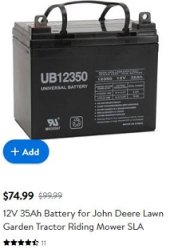The Harbor Freight "Thunderbolt" panels I had were amorphous silicon. They lost about 25% of their capacity in the first few months of operation, and more afterward. (By the way, that's acknowledged in the included instructions.) The four-panel set was heavy, cumbersome to set up, and fragile. I used them on and off for about three years with a 12-volt Group-27 size marine battery from Costco (about 100 amp-hours.) It worked pretty well to run ham radio gear and my CPAP in the tent, but the charge status info from the PWM controller was limited and vague. The panels lacked the capacity to ever complete a meaningful absorption or equalization phase. I calculated ~50 watts available charge in direct sun after battery losses.
If I had it to do over, for about the price of the Harbor Freight kit you can put together a starter system using a 100-watt, 12-volt Grape Solar monocrystaline panel from Home Depot, which will be easier to handle and set up, and will be more robust, efficient and long-lasting, and a 20-amp MPPT controller. Better yet, get with a group of like-minded friends and order a pallet of used 250-watt 24-volt panels from Santan Solar. One of those panels can provide 15+ amps charging at 12 volts using MPPT, or 8 amps even with a cheap PWM controller. If you order 10 panels or more, per-panel cost with shipping is less than new 100-watt 12-volt panels purchased individually.
If you have retired car batteries lying around, their best use in your situation is probably as core trades to get a discount on new Group 27 lead-acid marine batteries from Walmart or Costco. The new battery will weigh a little over 70 pounds, require occasionally adding distilled water, and emit a little gas during charging. But it will work well, has a second set of terminals for smaller cables, and is a good match to a solar panel in the 100 to 250-watt range. It's not a true deep cycle, but if you're running small stuff, you can stay within the top 50% of its capacity and it will work for years.
The Harbor Freight kit is aimed at people with limited knowledge who want to start quickly, have an old marine battery available, and don't have access to resources like this forum. It's a poor long-term value once you see what else is available for similar money. I ended up giving mine away to a friend who is starting out and wants to tinker.



